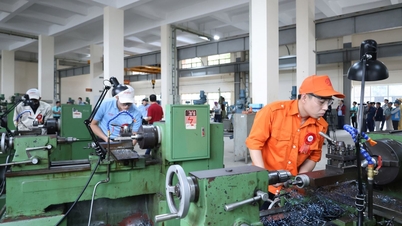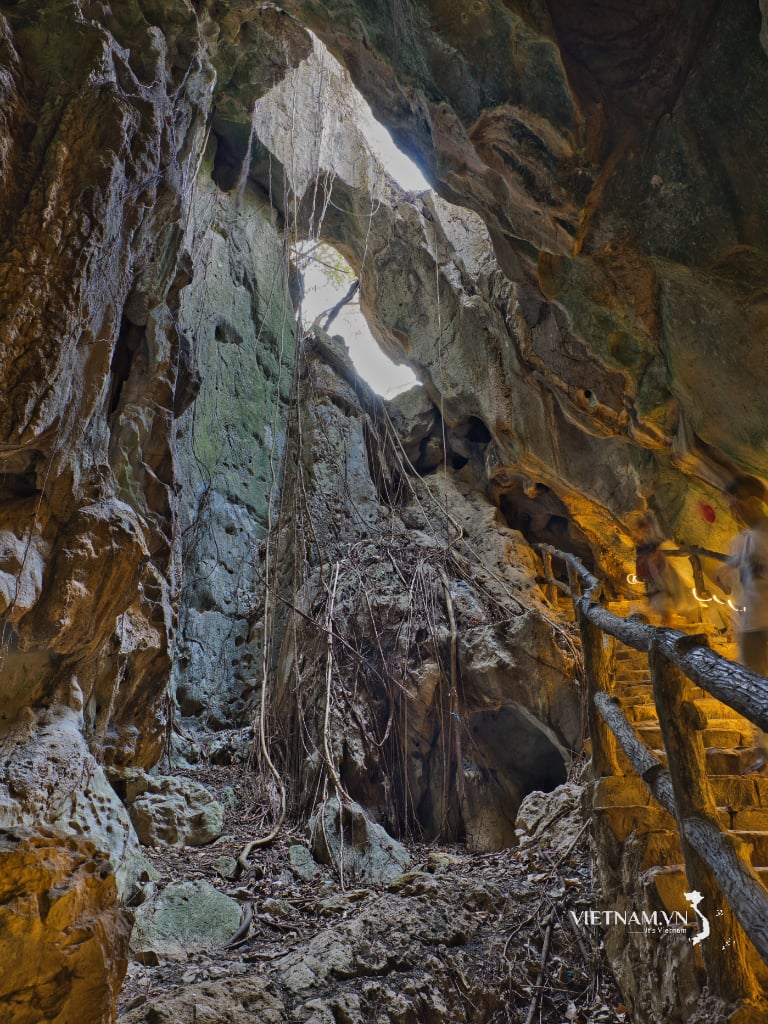Green infrastructure for clean transportation
Vietnam's oil and gas industry has a modern, synchronous energy infrastructure system, with a network of warehouses, ports, tanks, oil and gas pipelines covering the whole country, along with petrochemical refineries, gas processing plants and more than 13,000 petrol stations. This is a solid foundation for the transition to supplying clean fuels such as bio-fuel E10, B20, LNG, CNG or hydrogen without having to completely rebuild the distribution system but can be upgraded from existing infrastructure.

Model of PV GAS's integrated energy supply station. Photo: PV GAS.
Mastering the infrastructure of storage, pipelines, and distribution also means better management of logistics, quality, and environmental risk control during the transition. In the context of rapid urbanization and expanding transportation needs, this is the foundation for implementing “green transportation” from the fuel source side.
Along with that, the oil and gas industry also possesses the ability to supply large volumes and high coverage. Large-scale LNG terminals with a supply capacity of millions of tons/year are favorable conditions for expanding the use of liquefied natural gas (LNG). This system not only serves the needs of power generation and industry but is also capable of supplying urban transport projects using clean gas fuel, contributing to significantly reducing CO₂ emissions in large cities.
Currently, PV Power – the second largest electricity producer in Vietnam is promoting LNG power projects such as Nhon Trach 3 & 4, Hai Phong, Quang Ninh, creating a clean energy axis in key economic regions. Key distributors such as PVOIL also help make the deployment of E5/E10 or E20 biofuel much more feasible.
PVFCCo also takes advantage of high-quality urea raw materials and chemical production capacity to develop DEF – Phu My Xanh products, which help reduce up to 90% of NOx emissions from diesel engines when used with SCR technology. With the advantage of the distribution system, since June 2025, DEF – Phu My Xanh products have been widely distributed through the PVOIL petrol station system nationwide.

Ca Mau Gas - Power - Fertilizer Complex. Photo: Petrovietnam .
Not only having physical infrastructure, the Oil and Gas industry also possesses the capacity to operate a closed energy value chain: From "crude oil - transportation - processing - distribution" to "gas - electricity - fertilizer". Key units such as PV GAS, PVOIL, BSR have extensive experience in large-scale fuel storage, transportation, and distribution, ensuring safety and reducing environmental risks - key factors when expanding to new fuels such as LNG or hydrogen that few industries have. This allows the oil and gas industry to easily transition to clean fuels and new energy.
It can be seen that the energy infrastructure of the Oil and Gas industry is gradually greening with each steady step. Each ton of imported LNG, each liter of E10 or DEF – Phu My Xanh delivered to consumers demonstrates the determination of oil and gas workers in the journey to create clean transportation, green cities and a sustainable future.
Challenges in the early stages of transformation
The oil and gas industry has proactively restructured comprehensively to form a synchronous clean fuel ecosystem to promote green transportation, realizing the goal of reducing emissions. However, behind these changes are concerns in capital mobilization, calculating long-term investment efficiency and ensuring profits in the early stages of conversion...
To develop new fuels such as LNG, CNG, hydrogen or new generation biofuel, the oil and gas industry is forced to invest billions of dollars in port warehouse systems, pipelines, filling stations, storage technology, transportation and safety inspection. According to estimates, investment in clean energy projects of the oil and gas industry is 2-3 times higher than traditional projects, but the recovered profits are low due to small market size and unstable selling prices. While this technology is still not popular and depends on international cooperation, the cost and competitiveness of clean fuels are also barriers when the habit of using traditional fuels is still widespread. The lack of tax incentives, green credits and carbon pricing also causes many difficulties for businesses.

Maran Gas Achilles vessel enters Thi Vai LNG Terminal, marking the first and most important event in PV GAS's green energy transformation roadmap. Photo: PV GAS.
Although Vietnam has issued many green energy strategies, specific regulations for the development of new fuels such as hydrogen, green ammonia or sustainable aviation fuel (SAF) are still incomplete. The market model for LNG, hydrogen or biofuel is currently only at the experimental level, without technical standards and a complete certification system for commercialization. This makes businesses face risks when investing in new energy products, especially in the context of increasingly fierce global competition.
Another barrier is infrastructure and human resources. The clean fuel distribution system in large cities is still limited, and investment expansion faces many obstacles in terms of land, costs and technical safety. Meanwhile, high-quality human resources in the fields of green petrochemical technology, hydrogen production, or CCUS operation are still lacking. Retraining the existing team of engineers requires time, capital and extensive international cooperation.
The biggest challenge facing the Oil and Gas industry today is finding a balance between economic growth, emission reduction and ensuring national energy security. How to maintain a stable energy supply for socio-economic development while also fulfilling the responsibility of emission reduction and sustainable development in the context of Vietnam's energy demand still increasing by an average of 8-10% per year. Balancing short-term economic goals and long-term environmental benefits becomes a difficult problem to solve.
Because the Oil and Gas industry is still responsible for supplying the country's primary energy. Crude oil and natural gas play a key role in power generation, industry and transportation. Rapidly cutting fossil energy sources can cause risks of supply shortages, directly affecting production and life. Meanwhile, renewable energy such as wind, solar or hydrogen is still unstable and has high storage costs, and cannot be completely replaced in the short term. If we invest heavily in green transformation, short-term financial efficiency will decrease; but if we change slowly, the risk of falling behind in the global energy value chain is inevitable.
In order to ensure energy security, pioneer in emission reduction, and actively contribute to the country's green development goals, the oil and gas industry needs timely support from the State, through incentive mechanisms and a legal framework for new fuels.
Source: https://nongnghiepmoitruong.vn/nganh-dau-khi-nhien-lieu-sach-cho-giao-thong-xanh-bai-2-nen-tang-vung-chac-d783533.html


![[Photo] Chu Noodles - the essence of rice and sunshine](https://vphoto.vietnam.vn/thumb/1200x675/vietnam/resource/IMAGE/2025/11/11/1762846220477_ndo_tl_7-jpg.webp)




![[Photo] Prime Minister Pham Minh Chinh chairs a meeting on housing policy and the real estate market.](https://vphoto.vietnam.vn/thumb/1200x675/vietnam/resource/IMAGE/2025/11/11/1762838719858_dsc-2107-jpg.webp)

























































































![Dong Nai OCOP transformation: [Article 4] Reaching national standard products](https://vphoto.vietnam.vn/thumb/402x226/vietnam/resource/IMAGE/2025/11/11/1762825820379_4702-cac-san-pham-trai-cay-chung-nhan-ocop-nongnghiep-174649.jpeg)


![Dong Nai OCOP transition: [Article 3] Linking tourism with OCOP product consumption](https://vphoto.vietnam.vn/thumb/402x226/vietnam/resource/IMAGE/2025/11/10/1762739199309_1324-2740-7_n-162543_981.jpeg)






Comment (0)